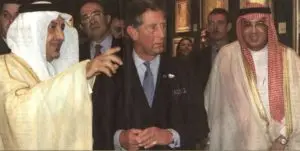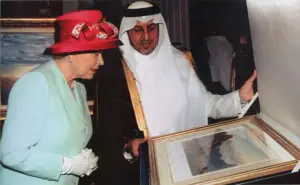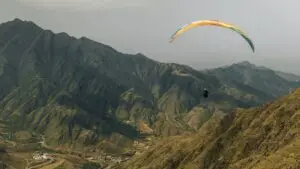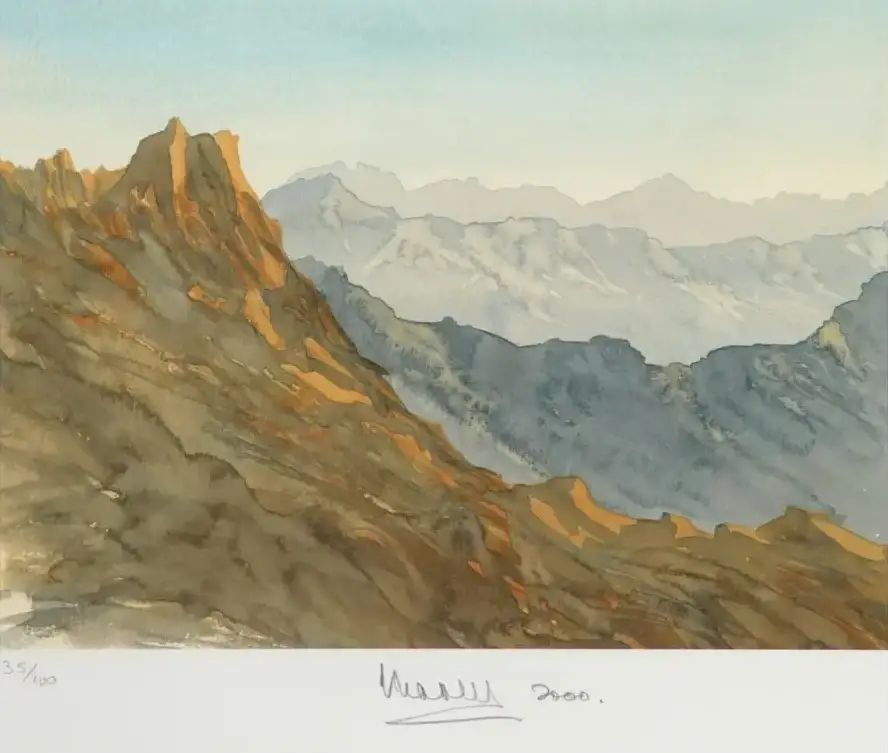Charles III, the artist King, is not just the most famous monarch on the planet but also a best-selling artist whose passion for art has significantly impacted his life and raised outstanding funds for his charities. Specializing in watercolor landscapes, his works often depict scenic locations in England and Scotland, as well as international destinations he visited as Prince of Wales.
In the 6th edition of the Konooz Fine Art Auction in London, under the patronage of HH Prince Faisal Bin Sultan Al Saud, and the auspices of the Arab Entrepreneurs Board in London, a signed lithograph of HM King Charles’ painting of Wadi Arkam, the mountain tops of Soudah in the Asir Province in Saudi Arabia, will be exhibited to commemorate 25 years of royal patronage of art and dedication to charitable foundations. This article delves into King Charles’ artistic pursuits, his admiration for the Middle East, the profound connections he has fostered through his art, and the significance of his painting to cultural exchange, heritage celebration, and tourism to the painted region.
Charles III, the Artist King
Not many people know that His Majesty King Charles III is a painter, and a very good one at that. Specializing in watercolor landscapes, the King has painted numerous scenes over many years, most depicting the royal family’s private property and castles in England and Scotland, but also including a few international locations he visited as Prince of Wales. Among his chosen places were Greece, Switzerland, and Saudi Arabia. Given his preference for painting outdoors to capture the essence of the places, we can infer that he sought beauty and peace in nature, as reflected in his paintings.
Charles III has admitted on more than one occasion that painting revolutionised his life and allowed him to “revive parts of the soul that other activities cannot.” In a display panel, he describes how the relaxing and therapeutic act of painting transports him into another dimension: “It all requires the most intense concentration and, consequently, is one of the most relaxing and therapeutic exercises I know. In fact, in my case, I find it transports me into another dimension which, quite literally, refreshes parts of the soul which other activities can’t reach.”
Overlooking Wadi Arkam, Asir Province
Since he was Prince of Wales, King Charles has always had a strong relationship with and admiration for the Middle East. This is reflected in his watercolor paintings, where he often draws inspiration from places like Wadi Arkam and Diriyah in Saudi Arabia, as well as Aqaba in Jordan.
In 1999, when HM King Charles visited the Kingdom of Saudi Arabia, he chose to paint two landscapes, one of which he titled: ‘Overlooking Wadi Arkam, Asir Province.’ He comments on his experience: “Painting in the Asir mountains is very challenging as the light and colours shift continually throughout the day. I have tried to capture something of the grandeur of the scenery, the peaceful atmosphere, and the effect of sunlight on the serried ranks of mountains.”
The Lithograph and Dedication to Charity
In 1990, King Charles decided to turn a few of his paintings into lithographs and sell them to raise money for his charitable foundations. He was approached by Anna Hunter who suggested they could produce his original watercolours into limited edition signed lithographs. As royal paintings are not usually signed, King Charles dated and signed every lithograph by hand in pencil. He personally chose which of his paintings should be made into lithographs and approved the colors and the process of the lithograph production, a technique developed in 1798 to create copies of precious paintings and maps.
Not all his paintings were made into lithographs. Out of all the Middle Eastern paintings and the two from Saudi Arabia, only ‘Overlooking Wadi Arkam’ was chosen for lithograph production. The printing of the image was supervised by The Prince of Wales, who signed each numbered copy. Upon completion of the printing, all the lithograph plates were canceled, preventing future productions and making the signed lithographs even more valuable and rare. We are fortunate to have the lithograph as the original watercolor painting will never be on sale and will remain in the Buckingham Palace collection.
A Tale of Two Princes
During his 1999 visit to Saudi Arabia, King Charles, then Prince of Wales, met HRH Prince Khalid Al Faisal Al Saud, who was the governor of the Asir Province, where King Charles painted the infamous watercolor. Also a painter and poet, Prince Khalid found common ground with Charles, and the two bonded over their love of art and its role in supporting local communities through charitable foundations. They decided to establish an initiative called Painting & Patronage to express the cultural ties between their kingdoms while raising money for their charities. The initiative was set to build bridges of artistic and educational understanding between the Arab world and Europe and to foster a deeper appreciation of each other’s distinct and diverse cultures and traditions.
Here, the ‘Wadi Arkam’ painting played an integral part in the largest cultural collaboration between Saudi Arabia and Britain. The painting was exhibited in the Painting & Patronage initiative. This unique art exhibition was staged at the Banqueting Hall, in the shadow of Big Ben and the Houses of Parliament in London in June 2000. The exhibition included 26 oil paintings by HRH Prince Khalid Al Faisal Al Saud and 30 recent watercolors by HRH the Prince of Wales, Prince Charles, who expressed at the opening of the exhibition: “It is my dearest wish that further initiatives will be organized which will help to bring closer together our two peoples and cultures.”



A special place in Riyadh
The exhibition was then shown in Riyadh in February 2001. It was opened on behalf of the Custodian of the Two Holy Mosques King Fahad bin Abdul Aziz by HRH Crown Prince Abdullah bin Abdul Aziz and held in the presence of leading members of the Royal Family and Government of Saudi Arabia, including the Governor of Riyadh, HRH Prince Salman bin Abdul Aziz Al-Saud (later Crown Prince), the Foreign Minister of Saudi Arabia, HRH Prince Saud Al-Faisal (brother of HRH Prince Khalid Al-Faisal), and the kingdom’s Interior Minister and later Crown Prince, HRH Prince Naief bin Abdul Aziz Al-Saud.
Numerous European senior statesmen, as well as public and cultural figures from across Europe, also attended, including T.M. King Simeon II and Queen Margarita of the Bulgarians, TRH The Duke and Duchess of Castro, the heads of The Prince of Venice Foundation and the Espirito Santo Foundation, and many diplomatic, business, and society figures.
Raising Money through Lithographs
Both princes went on to create lithographs from their Asir paintings. The sales of the lithographs in auctions (Asir and other scenes) raised substantial funds for their respective charities. According to the Telegraph and AlFaisal University, both King Charles III and Prince Khaled Al Faisal still raise money to their charities through their art.
King Charles III is one of the UK’s bestselling living artists, having made an estimated £2million for his charity from selling lithographs of his art from 1997 to 2016, with the King’s Lithographs going up in prices substantially since his accession to the throne.
We could not find any lithographs left for sale of the ‘Wadi Arkam’ painting, with the last one (number 35) bought in 2024 by Dr. Asma Ounnas to be displayed in its original frame at the Konooz Fine Art Auction. The exhibition will include a tour to explain the painting and lithograph’s history as part of the themed Royal Arab Art exhibition and Auction.
The Significance of the Painting
We don’t often see the true selves of royals; we only glimpse them through their speeches. However, their art reveals so much more. It is a window to the soul, where a picture indeed says more than a thousand words. Beyond the brush strokes and artistic innovation, we see their passion for their land, their traditions, and a love letter to the people. Art serves as a powerful medium for communicating one’s inner thoughts and emotions.
For almost a quarter of a century, the painting ‘Overlooking Wadi Arkam in Asir Provence’ has played a crucial role in showcasing the enduring relationship and cultural collaboration between the two countries. In the past 2 years, the lithograph have become even more significant, as the artist became a King, and the region he painted spotlights in the top of Saudi Crown Prince Mohammed Bin Salman‘s list for tourism development and heritage protection.
To the Arab Art & Cultural Community
It is not every day that a foreign King, and in particular the King of the United Kingdom, a much-beloved country to the Kingdom of Saudi Arabia, would paint an attraction that is considered the pride of the Saudi people.
On the Asir Area: King Charles mentioned to Prince Khalid Al Faisal: “In 1999 I had the chance to visit Asir again. It was a most magical two days in that part of the kingdom and not only did I have the chance to walk and paint, but Your Royal Highness showed me your studio. I have not had the chance to show you mine, which is perhaps just as well!”. It is worth mentioning that Prince Khalid, also a painter featured many sceneries of the Asir Provence landscapes and their community, folklore, and heritage. He also created lithographs of his paintings in 2007 just as King Charles did to raise money for his charities.
To Saudi Arabia Tourism
‘Overlooking Wadi Arkam’ is a beautiful painting of a beautiful and very significant place in the KSA, and it is no wonder why King Charles chose it as his subject of inspiration.
The mountains of Al Soudah in Asir, the highest peaks in Saudi Arabia, are famous for their beauty and distinct culture of the communities dwelling on the mountain peaks. There are many poems written describing the beauty of the region, including a famous poem by Prince Khalid Al Faisal. The region has distinct culture, geography, and traditions from the rest of the country. The dress of the region is unique, with traditionally colorful headbands for women and flower head wreaths for men.
According to VisitSaudi, the official website for KSA tourism, Asir is listed at the top of the list. As part of the country’s Vision 2023, many initiatives are set to highlight the importance of the continuous development of the Soudah region and the Asir Province, as well as aligning with the Kingdom’s strategy on sustainability, nature conservation, and ecosystem restoration.
On September 25, 2023, Saudi Crown Prince Mohammed Bin Salman announced the Soudah Peaks Project, a luxury mountain tourism destination 3,015 meters above sea level. The project is part of Saudi Vision 2030 and is expected to contribute $7.732 billion to Saudi’s GDP and generate thousands of jobs, with the aim to attract 2 million tourists throughout the year by 2033. The Saudi government and its ministry of culture are also applying to protect the area’s heritage and its local arts under the UNESCO’s intangible cultural heritage category. This shows the significance of Al Soudah and the Asir region to Saudi Arabia’s long-term strategy.

To the Everlasting Friendship Between the Two Kingdoms
The painting is a symbol of friendship between the United Kingdom and the Kingdom of Saudi Arabia. The signed lithograph of the painting has been exhibited in both countries and shown to Queen Elizabeth and Baroness Margaret Thatcher, as seen in the photos. Saudi Arabia takes pride in its strong, everlasting relationship with the UK. The lithograph materializes this relationship and serves as a reminder of the Painting & Patronage alliance between the two countries. Now that Charles is King, the painting will always represent that moment of peace and beauty that the King of the United Kingdom experienced at the highest mountain peak in Saudi Arabia.

